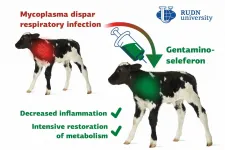(Press-News.org) Imaging planets orbiting around nearby stars, which could potentially harbour life, has become a possibility thanks to the progress made in observational methods by an international team of astronomers. First candidate: Alpha Centauri, a system similar to ours, "only" 4.3 light years away. This study is the subject of a publication in the journal Nature Communications.
Efforts to obtain direct images of exoplanets - planets outside our solar system - have so far been hampered by technological limitations, which have led to a bias towards detecting planets much larger than Jupiter, around very young stars and far from the habitable zone, the area in which a planet may have liquid water on its surface, and thus potentially life. "The Earth itself illuminates us at the wavelengths used for detection, and the infrared emissions from the sky, the camera and the telescope itself tend to drown out the signals we want to detect," says Kevin Wagner, NASA Hubble/Sagan post-doctoral fellow at the University of Arizona's Steward Observatory and first author of the paper. But the good reason to focus on these wavelengths is that this is where an Earth-like planet, in the habitable zone around a sun-like star, will shine the brightest. "
In other words, if astronomers want to find planets whose conditions are suitable for life as we know it, they must look for rocky planets the size of the Earth, within the habitable zones around older stars, similar to our Sun. And to do this, they have developed a new system for imaging exoplanets in the mid-infrared in combination with a very long observation time. This system, which was able to achieve unprecedented sensitivity by using a deformable secondary mirror to correct for the distortion of light induced by the Earth's atmosphere, used a coronagraph developed - thanks to an ERC grant - by researchers at ULiège. A starlight-blocking device which they optimised for the mid-infrared spectrum of light in order to block the light from one star at a time.
"We achieved the capability to directly image planets about three times the size of the Earth in the habitable zone of alpha Centauri," explains Olivier Absil, FNRS Research Associate and director of the PSILab (STAR Research Institute/Faculty of Sciences) at ULiège. Combined with efficient subtraction of thermal background noise, this method represents an improvement by a factor of 10 compared to existing capabilities for direct observation of exoplanets". Similar in effect to noise-canceling headphones, which allow soft music to be heard over a steady stream of unwanted jet engine noise, the technique allowed the team to remove as much of the unwanted noise as possible and detect the much fainter signals created by potential planet candidates inside the habitable zone.
Alpha Centauri, first candidate
Located only 4.3 light years away from our solar system, Alpha Centauri is a triple star system. It consists of two stars, Alpha Centauri A and B - which are similar in size and age to our Sun and orbit each other as a binary system - and Alpha Centauri C, better known as Proxima Centauri, a much smaller red dwarf that orbits its two sisters at a larger distance. "This system is the closest to ours," says Anne-Lise Maire, an astrophysicist at PSILab who also took part in the study. It proved to be an ideal candidate for testing our method, because Alpha Centauri A and B are similar to our Sun, but we don't know yet if there are planets orbiting either star. »
By moving one star on the coronagraph and one star off the coronagraph every tenth of a second, this technique has allowed researchers to observe each star for half the time, and more importantly it has allowed them to subtract one image from the next, which removes all but the noise of the camera and telescope. After removing the known artefacts created by the instrumentation and the residual light from the coronagraph, the final image revealed a light source designated as "C1", a plausible detection, which could be a planet the size of Neptune to Saturn, located at a distance from Alpha Centauri A similar to that between the Earth and the Sun, i.e. within the habitable zone. "At this stage however, without verification via a second observing campaign, we cannot exclude an instrumental artefact of unknown origin, or even the signature of an asymmetrical dust cloud," says Olivier Absil.
Another direct imaging campaign will be attempted in the coming years, and other methods (e.g. radial velocity measurements) could also provide an answer. In any case, these results demonstrate the potential of high-contrast imaging in the mid-infrared to enable the observation of Earth-like planets around nearby stars. "By 2028, the same type of coronagraph will equip the METIS instrument installed on the future ELT (Extremely Large Telescope), which will make it possible to image planets as small as the Earth in the habitable zone of alpha Centauri, and of a handful of other nearby stars," concludes Olivier Absil. The coronographs developed at the University of Liège are the result of more than 10 years of technological development, in partnership with the University of Uppsala, with funding from the European Research Council .
Finding a potentially habitable planet within Apha Centauri has been the goal of the initiative Breakthrough Watch/NEAR, which stands for New Earths in the Alpha Centauri Region, and involves researchers from the University of Liège. Breakthrough Watch is a global astronomical program looking for Earth-like planets around nearby stars. During the observation campaign, about 7 terabytes of data were collected. Data that the researchers made available to the public
INFORMATION:
Researchers from the University of Seville's Nursing Department, with the collaboration of professionals from the ICU at Virgen Macarena University Hospital in Seville, have analysed the key factors in caring for critical COVID-19 patients during the first wave of the pandemic. Their study concludes that nursing care was impacted by fear and isolation, which made it difficult to maintain the human experience of health care.
The break down in the humanising trend of ICU care during this period was mainly the result of the isolation of COVID-19 patients. This, along with the personal protection equipment worn by staff to prevent becoming infected ...
10,000 km2 of ice disappeared in a blink of an eye from an ice sheet in the Storfjorden Through offshore Svalbard, a new study shows. This dramatic break off was preceded by quite a rapid melt of 2.5 kilometres of ice a year. This parallels the current melt rates in Antarctica and Greenland and worries the scientists behind the study.
"Our measurements of the ice retreat in Storfjorden Through show that the prevailing conditions to the great break off, match what we see in Antarctica and Greenland today. It is uncanny. There are new studies published almost weekly, that show that the retreat of current ice sheets is two to four km a year and that it's speeding up." Says CAGE-professor and first author Tine Lander Rasmussen.
Climatically unstable period
The last deglaciation, ...
Two-dimensional (2D) materials have a huge potential for providing devices with much smaller size and extended functionalities with respect to what can be achieved with today's silicon technologies. But to exploit this potential we must be able to integrate 2D materials into semiconductor manufacturing lines - a notoriously difficult step. A team of Graphene Flagship researchers in Sweden and Germany now reports a new method to make this work.
The technique, just published in Nature Communications by researchers from Graphene Flagship partners RWTH Aachen University, Universität der Bundeswehr ...
New research from Trinity College Dublin suggests that older adults can be more focused, less impeded by anxiety and less mentally restless than younger adults. The team at the Trinity College Institute of Neuroscience (TCIN) (today, Wednesday, 10th February, 2021) show that older adults appear to mitigate the negative aspects of cognitive decline by increasing motivation and adopting more efficient strategies to suspend the wandering mind when focus is required.
The study, published in the journal Psychology and Aging (American Psychological Association) is the first to adjudicate between competing theories of age-related ...
In recent years, three meta-analyses of clinical studies have come to the conclusion that vitamin D supplementation was associated with a reduction in the mortality rate from cancer of around 13 percent. Scientists at the German Cancer Research Center (DKFZ) have now transferred these results to the situation in Germany and calculated: If all Germans over the age of 50 were to take vitamin D supplements, up to 30,000 cancer deaths per year could possibly be avoided and more than 300,000 years of life could be gained - in addition, health care costs could be saved.
For several years now, scientists have been investigating the influence of an adequate supply of vitamin D on the ...
Overfishing, hunting and intensive agriculture and forestry can sometimes contribute to plants and animals becoming endangered. New research from Lund University in Sweden and University of Toronto can now show why this leads to entire populations becoming smaller in size, as well as reproducing earlier. The study is published in the journal PNAS.
Researchers from Lund and Toronto are behind the study conducted on five different species of damselflies. They have studied how different environmental factors affect when and at what size the damselflies begin to reproduce. In the study, the researchers also shed light on how overfishing off the coast ...
COLUMBUS, Ohio - The death of a vampire bat 19 days after giving birth presented scientists studying the animals in 2019 with an unexpected chance to observe a rare event: a female bat's adoption of an unrelated baby.
The researchers had captured common vampire bats in Panama as part of ongoing studies of the formation of cooperative relationships among strangers. The team used infrared surveillance cameras to observe six hours of vampire bat activity spaced over the span of each day.
Two unrelated and unfamiliar female bats were observed forming a social bond based on mutual grooming and food sharing that increased over time. The researchers had named them BD and Lilith.
Lilith ...
Respiratory tract diseases in young animals of the cattle are a big issue for world agriculture and food safety because a bacterium that causes them is resistant to most antibiotics. A team of veterinarians from RUDN University developed and tested a complex preparation called gentaminoseleferon that could help treat respiratory infection in calves. The results of the study were published in the Veterinary World journal.
Bacteria of the genus Mycoplasma cause many infectious diseases in animals, including atypical pneumonia, other respiratory tract conditions, reproductive pathologies, arthritis, keratoconjunctivitis, mastitis, and so on. The genus includes about 200 species of bacteria, and all of them ...
Every day, people die from simple infections even though they have been treated with antibiotics. This is because more and more bacteria have become resistant to the types of antibiotics that doctors can prescribe.
- It's a huge societal problem and a crisis that we must solve. For example, by developing new antibiotics that can defeat the resistant bacteria, says professor of chemistry at the Department of Physics, Chemistry and Pharmacy, University of Southern Denmark, Poul Nielsen.
Resistant bacteria are not only known from pig farms, where it is becoming increasingly difficult to keep the pigsties disease-free. Hospitals are also experiencing with increasing regularity that, for example, infectious diseases cannot be controlled in patients. Thus, ...
Can long-term stress lead to heart attacks? Most people would probably answer in the affirmative, but the scientific evidence of this is scarce. A new study by researchers from Linköping University in Sweden reveals that the levels of the stress hormone cortisol were increased in the months preceding a heart attack. The results, published in Scientific Reports, suggest that long-term stress is a risk factor for heart attacks.
"The levels of the stress hormone cortisol differed between people who have had a heart attack and those not affected. This suggests that cortisol in hair may be a new risk marker for heart attacks. We must take stress seriously", says Professor Tomas Faresjö from the Department of Health, ...




